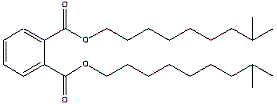


DIDP is a phthalate that is mainly used as additives in plastics to make them more flexible.
Its structure and applications are very similar to those of DINP. It has been widely used in everyday products, ranging from floorings to shoe soles.
In the 1990s, around 95% of DIDP was used in PVC as a plasticiser. More than half of the remaining 5% was used in the production of polymers other than PVC (e.g. rubbers). The remaining DIDP was used in non-polymer applications including anti-corrosion paints, anti-fouling paints, sealing compounds and textile inks.
At present, DIDP is banned in toys and childcare articles that children can put into their mouths (see European Directive 2005/84/EC)
Source: based on the GreenFacts study on Phthalates

Source: CERHR
GreenFacts Summary on Phthalate Di-isodecyl & Di-isononyl phthalates:
GreenFacts Summary on Phthalates in school supplies:
Deutsch: Diisodecylphthalat (DIDP)
Español: Diisodecilftalato (DIDP)
Français: Phtalate diisodécylique (DIDP)